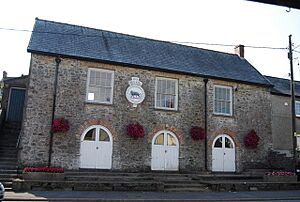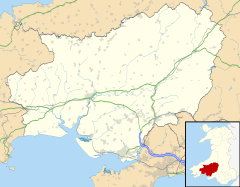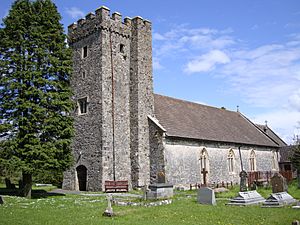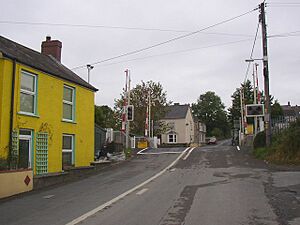St Clears facts for kids
Quick facts for kids St Clears
|
|
|---|---|
 St Clears Town Hall |
|
| Population | 2,995 (2011 census) |
| OS grid reference | SN275165 |
| Community |
|
| Principal area | |
| Ceremonial county | |
| Country | Wales |
| Sovereign state | United Kingdom |
| Post town | CARMARTHEN |
| Postcode district | SA33 |
| Dialling code | 01994 |
| Police | Dyfed-Powys |
| Fire | Mid and West Wales |
| Ambulance | Welsh |
| EU Parliament | Wales |
| UK Parliament |
|
St Clears (pronounced KLAIRZ; Welsh: Sanclêr) is a town in Carmarthenshire, Wales. It is located on the River Taf. In 2011, about 2,995 people lived there. The area also includes smaller places like Bancyfelin and Pwlltrap. St Clears is surrounded by other towns and villages in Carmarthenshire.
Contents
Discover St Clears: A Welsh Town
What's in a Name?
The name St Clears might come from a church founder named Clara from the 5th or 6th century. Another idea is that it comes from a Welsh word, Clair, which means an assembly of Welsh bards (poets and storytellers).
A Look Back in Time: St Clears' History
St Clears has a long and interesting history. Many important events happened here.
Ancient Buildings and Their Stories
The Priory Church of St Mary Magdalene is a very old and important building. It was built around the year 1100. This church is famous for having some of the best surviving Norman architecture stone carvings in Carmarthenshire. The church was repaired in the 1850s and 1880s. Its beautiful stained glass windows were added around 1929.
A Norman castle was also built in St Clears in the 12th century. The town of St Clears grew up around this castle. In 1405, the castle was taken over by Owain Glyndŵr, a famous Welsh leader.
Early Science and Important People
In the 16th century, a house called Trefenty House became home to part of the Perrot family. Here, an amateur astronomer named Sir William Lower and his friend John Protheroe set up one of Britain's first telescopes in 1609. They used it to study the Moon's craters and Halley's Comet.
Thomas Charles (1755–1814) was a very important Welsh clergyman. He was born near St Clears. He played a big role in the history of modern Wales.
The Rebecca Riots and Railway Changes
In 1842, St Clears was a key place during the "Rebecca Riots". During these protests, people dressed as women destroyed toll gates. At least one toll gate in St Clears was destroyed.
In the 1850s, the South Wales Railway was built. This railway caused many small ports along the Bristol Channel to decline, and St Clears was one of them. The railway passed about two miles north of the castle. New buildings then spread from the High Street towards the railway station. Today, Pentre Road is the main shopping area in St Clears.
Local Economy and Famous Residents
St Clears used to have an important cattle market, but it has now closed. However, the town still has a large agricultural store. In the past, there was also an oil distribution center and a milk processing plant. Now, smaller industrial businesses provide most of the local jobs.
Stanley Phillips (1910–1961) was a photographer and filmmaker who lived in St Clears. He took many pictures and made films about life in the town. His work appeared in major newspapers. His films, like The Last March of Mr. Jonah Rees at St Clears (1930), are kept at the National Library of Wales. An exhibition of his work in St Clears includes photos of famous people like aviator Amy Johnson and racing drivers Sir Malcolm Campbell and J. G. Parry-Thomas.
Neville Hughes (1945–2015) was born in St Clears. He was a British actor. Later, he became a very successful businessman in the car sales industry.
How St Clears is Governed
St Clears is also an electoral ward. This means people living here vote for councillors to represent them. These councillors work for Carmarthenshire County Council and the St Clears Town Council. The St Clears Town Hall is a historic building, but it is no longer used for town meetings.
St Clears and the Railway
The original railway was built by the South Wales Railway. Even though trains still travel through St Clears on the West Wales line, they have not stopped here since 1964. However, there has been a local effort to reopen St Clears railway station. Funding has now been secured to make this happen by 2024.
Life in St Clears: Amenities and Activities
St Clears has a large primary school called Ysgol Griffith Jones. It teaches children in both Welsh and English.
The town has many local shops, including two award-winning traditional butchers. There are also two craft centers and several pubs.
The countryside around St Clears is mostly green fields with well-kept hedges. The main type of farming here is dairy farming, but sheep and beef farming are also very important. The soil is good for growing potatoes and grains. The climate also allows for fruit growing. Even though most of the land is farmed, the area is also home to lots of wildlife.
A big event in the farming year is the St Clears YFC annual show. It takes place every May.
Sports in St Clears
The local association football club is called St Clears AFC. They play in the Pembrokeshire League.
See also
 In Spanish: St Clears para niños
In Spanish: St Clears para niños




